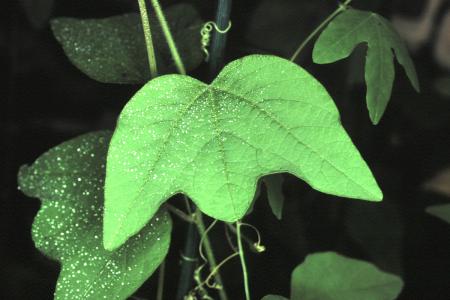
SUBGENUS: decaloba
SUPERSECTION: decaloba
SECTION: decaloba
MINIMUM TEMPERATURE: 5 °C
IDEAL MINIMUM TEMPERATURE: 10 °C
SYNONYMS: P. capsularis var. geminifolia DC., P. floribunda Lemaire, P. isotriloba Cuf., P. melahelos Gilli, P. miraflorensis Killip, P. obscura Lindley, P. pannosa J. E. Sm., P. triflora Macf.
ETYMOLOGY: So called as it produces six flowers at the stem knot.
DESCRIPTION:
The synonym P. isotriloba (meaning three equal lobes) highlights the leaf's peculiarity of having three lobes of equal length. A straight line drawn between the pointed apices of the two external lobes will also pass through the central one. It is evident that, unlike many plants belonging to the subgenus Decaloba, the usually non-existent central lobe is so pronounced here as to be recognisable.
The whole plant is pleasantly velvety, with the large leaves, 8 cm long and 12 cm wide, in particular, seemingly made from soft fabric.
The 3 cm diameter flowers are composed of hairy sepals on the underside and of the same white colour as the petals on the other. The corona is made up of two series of filaments. The outermost has filaments that are dark purple at the base and white at the apex. The inner one is composed of shorter purple filaments with a truncated apex.
The globose fruits, with a diameter of about 1 cm, are also velvety.
This passionflower is still little known or cultivated; it is only in the last few years that it has been gaining ground among collectors. It is a pot plant with elegant foliage, easy to grow and very hardy (tolerating a minimum temperature of about 4°C), coming as it does from the high mountain ranges that rise between Florida and Colombia. I believe it could acclimatise in citrus-growing areas and in protected positions in olive-growing areas, trusting in the fact that fleeting drops in temperature will not cause serious damage. In summer, it requires frequent watering.
It
propagates easily from both seeds and cuttings.